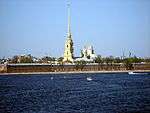Shneur Zalman of Liadi
| Shneur Zalman of Liadi | |
|---|---|
| Alter Rebbe | |
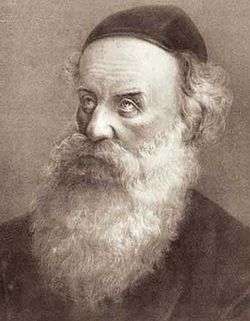 | |
| Term | gradual – 1812-12-15 OS |
| Full name | Shneur Zalman Borukhovich |
| Main work | Tanya, Shulchan Aruch HaRav |
| Born |
1745-09-04 OS Liozna, Polish–Lithuanian Commonwealth |
| Died |
1812-12-15 OS Pena, Kursk Governorate Russian Empire |
| Buried | Hadiach |
| Dynasty | Chabad |
| Predecessor | Dovber of Mezeritch |
| Successor | Dovber Schneuri |
| Father | Boruch |
| Mother | Rivkah |
| Wife | Sterna Segal |
| Children |
Dovber Schneuri Devorah Leah Rochel |
Shneur Zalman of Liady[1] (Hebrew: שניאור זלמן מליאדי, September 4, 1745 – December 15, 1812 O.S. / 18 Elul 5505 – 24 Tevet 5573), was an Orthodox rabbi and the founder and first Rebbe of Chabad, a branch of Hasidic Judaism, then based in Liadi in the Russian Empire. He was the author of many works, and is best known for Shulchan Aruch HaRav, Tanya and his Siddur Torah Or compiled according to the Nusach Ari.
He is also known as the "Baal HaTanya" (Master of the Tanya), and by a variety of other names including "Shneur Zalman Baruchovitch," Baruchovitch being the Russian patronymic from his father Baruch,[2] by the acronym "RaShaZ" (רש"ז), by the title "Baal HaTanya ve-haShulchan Aruch'" (Master of the Tanya and the Shulchan Aruch), as the "Alter Rebbe" ("Old Rebbe" in Yiddish), "Admor HaZaken" ("Old Rebbe" in Hebrew), "Rabbeinu HaZokein", "Rabbeinu HaGodol", "our great rabbi", the "GRaZ", and "Rav".
Biography
Early life
Shneur Zalman was born in 1745 in the small town of Liozna, Polish–Lithuanian Commonwealth (present-day Belarus). He was the son of Baruch,[3] great5-grandson of the mystic and philosopher Judah Loew ben Bezalel, the "Maharal of Prague".[4] He was a prominent (and the youngest) disciple of Dovber of Mezeritch, the "Great Maggid", who was in turn the successor of the founder of Hasidic Judaism, Yisroel ben Eliezer, known as the Baal Shem Tov.
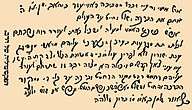
He displayed extraordinary talent while still a child. By the time he was eight years old, he wrote an all-inclusive commentary on the Torah based on the works of Rashi, Nahmanides and Abraham ibn Ezra.[5]
Until the age of twelve, he studied under Issachar Ber in Lyubavichi (Lubavitch); he distinguished himself as a Talmudist, such that his teacher sent him back home, informing his father that the boy could continue his studies without the aid of a teacher.[6]
At his Bar Mitzvah celebration, he delivered a discourse concerning the complicated laws of Kiddush Hachodesh, to which the people of the town granted him the title "Rav".[4]
At age fifteen he married Sterna Segal, the daughter of Yehuda Leib Segal, a wealthy resident of Vitebsk, and he was then able to devote himself entirely to study. During these years, Shneur Zalman was introduced to mathematics, geometry and astronomy by two learned brothers, refugees from Bohemia, who had settled in Liozna. One of them was also a scholar of the Kabbalah. Thus, besides mastering rabbinic literature, he also acquired a fair knowledge of the sciences, philosophy, and Kabbalah. He became an adept in Isaac Luria's system of Kabbalah, and in 1764 he became a disciple of Dov Ber of Mezeritch. In 1767, at the age of 22, he was appointed maggid of Liozna, a position he held until 1801.
Children and succession
Rabbi Shneur Zalman's sons were: Dovber Schneuri who eventually succeeded him, Chaim Avraham, and Moshe, who allegedly converted to Catholicism.[7] Moshe's apostasy is negated by Chabad sources, but supported by Belarusian State archives in Minsk uncovered by historian Shaul Stampfer.[7] Rabbi Shneur Zalman's daughters were named Freida, Devorah Leah and Rochel. Other families have lore telling that they are also descendants of the Alter Rebbe, but they are undocumented in existing family records of the Alter Rebbe's descendants.
Dovber Shneuri
Rabbi Dovber Schneuri succeeded his father as Rebbe of the Chabad movement.
At the age of 39, while studying in the city of Kremenchug, his father died.[8] He then moved to the small border-town of Lubavichi, from which the movement would take its name.[8] His accession was disputed by one of his father's prime students, Rabbi Aharon HaLevi of Strashelye, however the majority of Shneur Zalman's followers stayed with Dovber, and moved to Lubavichi.[8] Thus Chabad had now split into two branches, each taking the name of their location to differentiate themselves from each other.[8] He established a Yeshivah in Lubavitch, which attracted gifted young scholars. His son-in-law, Rabbi Menachem Mendel of Lubavitch, headed the Yeshivah, and later became his successor.
Thus, while Rabbi Dovber Schneuri succeeded his father as Rebbe of the Chabad movement, a senior disciple of his father, Rabbi Aharon HaLevi of Strashelye, a popular and respected figure, differed with him on a number of issues and led a breakaway movement.
Strashelye
When Schneur Zalman died, many of his followers flocked to one of his top students, Rabbi Aharon HaLevi of Strashelye. He had been Shneur Zalman’s closest disciple for over thirty years. While many more became followers of Dovber Shneuri, known to his followers as the Mittler Rebbe, the Strashelye school of Chassidic thought was the subject of many of Dovber's discourses. Reb Aharon HaLevi emphasized the importance of basic emotions in divine service (especially the service of prayer). The Mittler Rebbe did not reject the role of emotion in prayer, but emphasized that if the emotion in prayer is to be genuine, it can only be a result of contemplation and understanding (hisbonenus) of the explanations of Chassidus, which in turn will lead to an attainment of "bittul" (self-nullification before the Divine). In his work entitled Kuntres Hispa'alus ("Tract on Ecstasy"), the Mittler Rebbe argues that only through ridding oneself of what he considered disingenuous emotions could one attain the ultimate level in Chassidic worship (that is, bittul).[9]
Moshe Schneersohn
Moshe Schneersohn (born c. 1784 - died, before 1853) was the youngest son of the founder of Chabad-Lubavitch Hasidism, Rabbi Shneur Zalman of Liadi. According to some scholars he converted to Christianity and died in a St. Petersburg asylum. Chabad sources say that his conversion and related documents were faked by the Church. His conversion and mental infirmity and apostasy have been denied by the Chabad movement consistently since his death.[10]
Documents found by historian Shaul Stampfer apparently document Schneersohn's conversion to Christianity. The original documents are located in the National Historical Archives in Minsk, Belarus. These include a letter to the local priest in which he states his intent to convert and his baptismal certificate dated July 4, 1820. The documents also show that after his conversion he worked for the Tsar to assist in the conversion of other Jews.[10]
Lithuania
During the latter portion of Rabbi Dovber’s life, his students dispersed over Europe, and after Rabbi Dovber's death, Rabbi Shneur Zalman became the leader of Hasidism in Lithuania, along with his senior colleague Menachem Mendel of Vitebsk. When Rabbi Menachem Mendel died (in 1788), Rabbi Schneur Zalman was recognized as leader of the Chassidim in Lithuania.[11]
At the time Lithuania was the center of the misnagdim (opponents of Hasidism), and Rabbi Shneur Zalman faced much opposition. In 1774 he and Menachem Mendel of Vitebsk traveled to Vilna in an attempt to create a dialogue with the Vilna Gaon who led the Misnagdim and had issued a ban (cherem) against the Hasidim, but the Gaon refused to see them (see Vilna Gaon: Antagonism to Hasidism and Hasidim and Mitnagdim).
Undaunted by this antagonism, he succeeded in creating a large network of Hasidic centers. He also joined opposition to Napoleon's advance on Russia by recruiting his disciples to the Czar's army,.[12] He was also active in canvassing financial support for the Jewish settlements in the Land of Israel, then under the control of the Ottoman Empire.
Philosophy: Chabad
.jpg) |
| Part of a series on |
| Chabad |
|---|
| Rebbes |
|
| Places and landmarks |
| History |
| Organizations |
| Schools |
| Chabad philosophy |
| Texts |
| Outreach |
| Terminology |
| Chabad offshoots |
As a Talmudist, Rabbi Shneur Zalman endeavored to place Kabbalah and Hasidism on a rational basis. In his seminal work, Tanya, he defines his approach as "מוח שולט על הלב" ("mind ruling over the heart/emotions"). He chose the name "Chabad" for this philosophy—the Hebrew acronym for the intellectual attributes (sefirot) Chochma ("wisdom"), Bina ("understanding"), and Da'at ("knowledge”).
Both in his works and in his sermons he "indicated an intelligent and not a blind faith",[11] and assumed an intellectual accessibility of the mystical teachings of the Kabbalah. This intellectual basis differentiates Chabad from other forms of Hasidism - in this context referred to as "Chagas"[13]—the "emotional" attributes (sefiros) of Chesed ("kindness"), Gevurah ("power"), and Tiferes ("beauty").
Opposition to Napoleon and support for the Tsar

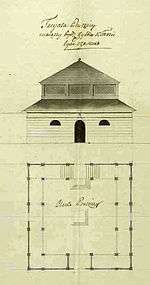
During the French invasion of Russia, while many Polish Hasidic leaders supported Napoleon or remained quiet about their support, Rabbi Shneur Zalman openly and vigorously supported the Tsar.
While fleeing from the advancing French army he wrote a letter explaining his opposition to Napoleon to a friend, Rabbi Moshe Meizeles:[14]
| “ | Should Napoleon be victorious, wealth among the Jews will be abundant. . .but the hearts of Israel will be separated and distant from their father in heaven. But if our master Alexander will triumph, though poverty will be abundant. . . the heart of Israel will be bound and joined with their father in heaven. . . And for God's sake: Burn this letter.[15] | ” |
Some argue that Rabbi Shneur Zalman's opposition stemmed from Napoleon's attempts to arouse a messianic view of himself in Jews, opening the gates of the ghettos and emancipating their residents as he conquered. He established an ersatz Sanhedrin, recruiting Jews to his ranks, and spreading rumors about his conquest of the Holy Land to make Jews subversive for his own ends.[16] Thus, his opposition was based on a practical fear of Jews turning to the false messianism of Napoleon as he saw it.[14]
It should be noted that Rabbi Yisroel Hopsztajn of Kozienice, another Hasidic leader, also considered Napoleon a menace to the Jewish people,[17] but believed that after victory over Russia, Messiah will arrive. Rabbi Menachem Mendel Schneerson identifies Rabbi Yisroel as the Chasidic leader who preferred that Napoleon defeat the Czar.[18]
Arrests
In 1797 following the death of the Gaon, leaders of the Vilna community falsely accused the Hasidim of subversive activities - on charges of supporting the Ottoman Empire, since Rabbi Shneur Zalman advocated sending charity to support Jews living in the Ottoman territory of Palestine. In 1798 he was arrested on suspicion of treason and brought to St. Petersburg where he was held in the Petropavlovski fortress for 53 days, at which time he was subjected to an examination by a secret commission. Ultimately he was released by order of Paul I of Russia. The Hebrew day of his acquittal and release, 19 Kislev, 5559 on the Hebrew calendar, is celebrated annually by Chabad Hasidim, who hold a festive meal and make communal pledges to learn the whole of the Talmud; this practice is known as "Chalukas Ha'Shas".
In Habad tradition, his imprisonment is interpreted as a reflection of accusations in Heaven that he was revealing his new dimensions of mystical teachings too widely. The traditional tendency to conceal Jewish mysticism is founded on the Kabbalistic notion of the Sephirot. The side of Divine Chesed seeks to give physical and spiritual blessing without restriction. This is counterbalanced by the side of Gevurah, which measures and restricts the flow to the capacity and merit of the recipient. The subsequent Sephirah of Hod implements any restriction in order to preserve the glory of the Divine majesty. In the Hasidic story of an earlier episode among the "Holy Society" disciples of Dov Ber of Mezeritch, one of the great followers saw a page of Hasidic writings blowing around the courtyard. He regretted the undue dissemination of Hasidut for its desecration of Divine holiness. In the account, his vocalisation of these thoughts caused a Heavenly accusation against the Maggid, for revealing too much. The young Schneur Zalman replied with a famous Hasidic parable:[19]
A king had an only son who became ill and all the attending doctors were at a loss of how to heal him. A wise person understood the only possible cure. He told the king that he would have to desecrate the royal crown by removing its most precious jewel. This would have to be ground up and fed to the king's son. The king regretted the loss to his majesty but immediately agreed that the life of his son was more important. The jewel was ground and the solution was fed to the son. Most of the cure fell to the ground, but the son received a few drops and became cured. Concluded Schneur Zalman in defence of Hasidic dissemination, the king represents God, and the son represents the Jewish community, who recognise the "God of Israel". At the time of the emerging Hasidic movement, the Jewish people were at a physical and spiritual low ebb. The only cure would be the dissemination of the inner Divine teachings of Hasidic thought. Even though this would also involve their desecration, this would fully be justified in order to heal the people. The accusing student of the Maggid realised the wisdom of this, and agreed with Schneur Zalman. When the Maggid heard about this, he told Schneur Zalman that "you have saved me from the Heavenly accusation".
The story of this parable is famous across other Hasidic dynasties as well. Habad commentary asks about this the question of why a new Heavenly accusation would have arisen against Rabbi Schneur Zalman himself, and result in his incarceration in St. Petersburg. Had he not already received the Heavenly agreement to the wisdom of disseminating Chassidic teachings? Since Habad thought presented Hasidic thought with a new degree of elucidation in intellectual form, this caused a new, more severe Heavenly accusation to emerge. This went beyond the justified spiritual revival and healing of mainstream Hasidism. Here, in Hasidic thought, Schneur Zalman was seeking to fulfill the Messianic impulse to disseminate Hasidic philosophy as a preparation for Mashiach. Therefore, his subsequent exoneration by the Tzarist authorities is interpreted in Habad as a new Heavenly agreement to begin the fullest dissemination of Hasidic thought without its prior limitations. Habad tradition tells that in prison, Schneur Zalman was visited by the deceased Baal Shem Tov and Maggid of Mezeritch, who told him the reason for his imprisonment. In reply to the question of whether he should stop, they replied that once released, he should continue with even more dedication. Therefore, in Habad thought, the 19th day of Kislev is called the "New Year of Hasidut", complementing the other 4 Halachic "New Year" dates in the Hebrew calendar.
In 1800 Rabbi Shneur Zalman was again arrested and transported to St. Petersburg, this time along with his son Moshe who served as interpreter, as his father spoke no Russian or French. He was released after several weeks but banned from leaving St. Petersburg.[20] The elevation of Tsar Alexander I (Alexander I of Russia) a few weeks later led to his release; he was then “given full liberty to proclaim his religious teachings” by the Russian government.
According to some, his first arrest was not the result of anti-Hasidic agitators fabricating charges, or officials seeking extortion monies.[14][21] An accusation was made on May 8, 1798 by Hirsh ben David of Vilna accused him of trying to assist the French Revolution, by sending money to Napoleon and the Sultan. Since this Hirsch ben David was untraceable, some were led to believe that there was no such person as Hirsh and the authorities were attempting to stir up internecine fighting among the Jews.[14]
Liadi
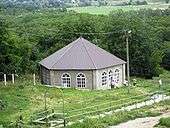

After his release he moved his base to Liadi, Vitebsk Region, Imperial Russia; rather than returning to Liozna, he took up his residence in the town of Liadi at the invitation of Prince Stanisław Lubomirski, voivode of the town. There his movement grew immensely, and he is still associated with the town to this day. In 1812, fleeing the French Invasion, he left Mogilev, intending to go to Poltava, but died on the way in the small village of Pena, Kursk Oblast. He is buried in Hadiach.
Subsequent history of Chabad
Rabbi Dovber Schneuri moved the movement to the town of Lubavitch (Lyubavichi) in present-day Russia. A top follower of Rabbi Shneur Zalman, Rabbi Aharon HaLevi Horowitz, established a rival Chabad school in Strashelye, which did not last after his death.
In 1940, under the leadership of the previous Rebbe, Rabbi Yosef Yitzchok Schneersohn, the Chabad-Lubavitch movement moved its headquarters to Brooklyn, New York in the United States. Under the leadership of Rabbi Menachem Mendel Schneerson, Chabad established branches all over the world staffed by its own Lubavitch-trained and ordained rabbis with their wives and children. The number of branches continues to grow to this day, and existing branches continue to expand.
Many descendants of Rabbi Shneur Zalman carry surnames such as Shneur, Shneuri, Schneerson, and Zalman.
Works
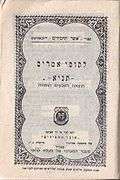
Rabbi Shneur Zalman was a prolific writer. He produced works of both mysticism and Jewish law. Chabad tradition recasts his Yiddish name "Shneur" (שניאור) as the two Hebrew words "Shnei Ohr" (שני אור-Two Lights), referring to Schneur Zalman's mastery of both the outer dimensions of Talmudic Jewish study, and the inner dimensions of Jewish mysticism. His works form the cornerstone of Chabad philosophy. His ability to explain even the most complex issues of Torah made his writings popular with Torah scholars everywhere.
Tanya
He is probably best known for his systematic exposition of Hasidic Jewish philosophy, entitled Likkutei Amarim, more widely known as the Tanya, said to be first published in 1797. The legendary 1797 Tanya got lost in a fire and no copies survived. The extant and more authoritative version of this work dates from 1814. Due to the popularity of this book, Hasidic Jews often refer to Rabbi Shneur Zalman as the Baal HaTanya (lit. "Master of the Tanya"). The Tanya deals with Jewish spirituality and psychology from a Kabbalistic point of view, and philosophically expounds on such themes as the Oneness of God, Tzimtzum, the Sefirot, simcha, bitachon, among many other mystical concepts.
Shulchan Aruch HaRav
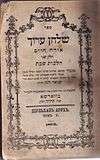
Rabbi Shneur Zalman is well known for the Shulchan Aruch HaRav, a collection of authoritative codes of Jewish laws and customs commissioned by Rabbi Dovber of Mezeritch and composed at the legendary age of twenty. The Maggid of Mezeritch sought a new version of the classic Shulkhan Arukh for the Hasidic movement. The work states a selection of decided halakha, as well as the underlying reasoning, and common Hasidic customs. The Shulchan Aruch HaRav is considered authoritative by other Hasidim, and citations to this work are many times found in non-Hasidic sources such as the Mishnah Berurah used by Lithuanian Jews and the Ben Ish Chai used by Sephardic Jews. Rabbi Shneur Zalman is also one of three halachic authorities on whom Shlomo Ganzfried based his Kitzur Shulkhan Arukh (Concise version of Jewish law).
Siddur
He also edited the first Chabad siddur, based on the Ari Siddur of the famous kabbalist Rabbi Isaac Luria (Arizal) of Safed, but he altered it for general use, and corrected its textual errors. Today's Siddur Tehillat HaShem is a later print of Shneur Zalman's Siddur.
Music
Rabbi Shneur Zalman composed a number of Hassidic melodies. Some accompany certain prayers, others are sung to Biblical verses or are melodies without words. Depending on the tune they are meant to arouse joy, spiritual ecstasy or teshuvah. One special melody, commonly referred to as The Alter Rebbe's Niggun or Dalet Bovos, is reserved by Chabad Hassidim for ushering a groom and bride to their wedding canopy and other select occasions.
Other
Rabbi Shneur Zalman's other works include:
- Torah Or and Likutei Torah, chassidic explanations of the weekly Torah portions, Shir HaShirim and the Book of Esther, drawn from his Hasidic Discourses and published by his grandson, the Tzemach Tzedek, who added his own glosses.
- Sefer HaMa'amorim, also known as Maamarei Admur HaZakein, Hasidic Discourses: Hanachot HaRaP; Et’haleich Lyozna; 5562- 2 vol.; 5563, 2 vol.; 5564; 5565, 2 vol.; 5566; 5567; 5568, 2 vol.; 5569; 5570; 5571; Haketzarim; Al Parshiyot HaTorah VehaMoadim, 2 vol.; Inyanim; Ma’amarei Razal; Nach, 3 vol.
- Hilchot Talmud Torah, on the study of Torah.
- Sefer She’elot Uteshuvot, Responsa.
- Siddur Im Dach, a prayerbook with Hasidic discourses
- Boneh Yerushalayim.
- Me'ah She'arim.
- Igrot Kodesh, 2 vol.
References
- ↑ Schloss, Chaim (2002). A Chassidic journey. Feldheim. p. 199. Retrieved July 14, 2009.
- ↑ Lionel Menuhin Rolfe The Menuhins: a family odyssey - 1978 "Judah Lieb and Sara had a son named Moshe, who had a son named Schneur Zalman. This first Schneur Zalman married a woman named Rachel and they had a son named Baruch. Baruch married Rebeka, a descendant of The MaHarShal."
- ↑ Lubavitcher Rabbi's memoirs: The memoirs of Rabbi Joseph Isaac Schneersohn 1971 "Judah Loewe, as follows: Rabbi Judah — Betzalel — Samuel — Judah Leib — Moses of Posen — Shneur Zalman — Baruch — Shneur Zalman of Liady "
- 1 2 Hayom Yom, introduction
- ↑ 'Sipurie Chassidim Lenoar' Kfar Chabad 1984
- ↑ The Lubavitcher Rebbe's Memoirs, vol 1.
- 1 2 The Jewish Daily Forward, 25 August 2006, "New Book Reveals Darker Chapters In Hasidic History," http://forward.com/articles/1094/new-book-reveals-darker-chapters-in-hasidic-histor/
- 1 2 3 4 Encyclopedia of Hasidism, entry: Schneuri, Dovber. Naftali Lowenthal. Aronson, London 1996. ISBN 1-56821-123-6
- ↑ Ehrlich, Leadership in the HaBaD Movement, pp. 160–192, esp. pp. 167–172.
- 1 2 New Book Reveals Darker Chapters In Hasidic History, Allan Nadler, August 25 2006, (Review of Assaf's book in The Jewish Daily Forward)
- 1 2 “Shneor Zalman Ben Baruch”. jewishencyclopedia.com.
- ↑ Rabbi Schneur Zalman of Liadi, Rabbi Nissan Mindel, New York: Kehot, 1973, pp. 251–252
- ↑ "Reference of Rebbe Rayatz to Chassidei "''Chagas''"". Chabadlibrary.org. Retrieved 2012-01-13.
- 1 2 3 4 Should Napoleon be victorious...": Politics and Spirituality in Early Modern Jewish Messianism, Hillel Levine, Jerusalem Studies in Jewish Thought 16–17, 2001
- ↑ Napoleon u-Tekufato, Mevorach, pp. 182–183
- ↑ Napoleon and the Jews, Kobler, F., New York, 1976.
- ↑ A. Marcus, HaChasiduth, p. 114.
- ↑ Igros Kodesh, Vol. 15, p. 450.
- ↑ The Great Maggid by Jacob Immanuel Schochet. Kehot Publications
- ↑ On learning Chassidus, Brooklyn, 1959, p. 24
- ↑ Kerem Chabad, Kefar Habad, 1992, pp. 17–21, 29–31 (Documents from the Prosecutor General's archive in St. Petersburg
External links
| Wikiquote has quotations related to: Shneur Zalman of Liadi |
- Rabbi Schneur Zalman 1745–1812, chabad.org
- Founder of Chabad, chabad.org
- The Alter Rebbe, lessonsintanya.com
- Rabbi Schneur Zalman of Liadi, Adin Steinsaltz
- Rabbi Shneiur Zalman of Ladi (1746–1812), Prof. Eliezer Segal
- Shneor Zalman Ben Baruch, jewishencyclopedia.com
- Rabbi Shneur Zalman of Liadi 5505–5573 (1745–1812), asknoah.org
- What is Lubavitch Chasidism and Chabad?, scjfaq.org
- Philosophy of Chabad, chabadofeugene.org
- Family Tree
- Books by Rabbi Shneur Zalman From chabadlibrary.org
 |
| Religious titles | ||
|---|---|---|
| Preceded by Rabbi Dovber of Mezeritch |
Rebbe of Lubavitch gradual—1812 |
Succeeded by Dovber Schneuri |
| Schneersohn Family Tree (partial) | ||||||||||||||||||||||||||||||||||||||||||||||||||||||||||||||||||||||||||||||||||||||||||||||||||||||||||||||||||||||||||||||||||||||||||||||||||||||||||||||||||||||||||||||||||||||||||||||||||||||||||||||||||||||||||||||||||||||||||||||||||||||||||||||||||||||||||||||||||||||||||||||||||||||||||||||||||||||||||||||||||||||||||||||||||||||||||||||||||||||||||||||||||||||||||||||||||||||||||||||||||||||||||||||||||||||||||||||||||||||||||||||||||||||||||||||||||||||||||||||||||||||||||||||||||||||||||||||||||||||||||||||||||||||||||||||||||||||||||||||||||||||||||||||||||||||||||||||||||||||||||||
|---|---|---|---|---|---|---|---|---|---|---|---|---|---|---|---|---|---|---|---|---|---|---|---|---|---|---|---|---|---|---|---|---|---|---|---|---|---|---|---|---|---|---|---|---|---|---|---|---|---|---|---|---|---|---|---|---|---|---|---|---|---|---|---|---|---|---|---|---|---|---|---|---|---|---|---|---|---|---|---|---|---|---|---|---|---|---|---|---|---|---|---|---|---|---|---|---|---|---|---|---|---|---|---|---|---|---|---|---|---|---|---|---|---|---|---|---|---|---|---|---|---|---|---|---|---|---|---|---|---|---|---|---|---|---|---|---|---|---|---|---|---|---|---|---|---|---|---|---|---|---|---|---|---|---|---|---|---|---|---|---|---|---|---|---|---|---|---|---|---|---|---|---|---|---|---|---|---|---|---|---|---|---|---|---|---|---|---|---|---|---|---|---|---|---|---|---|---|---|---|---|---|---|---|---|---|---|---|---|---|---|---|---|---|---|---|---|---|---|---|---|---|---|---|---|---|---|---|---|---|---|---|---|---|---|---|---|---|---|---|---|---|---|---|---|---|---|---|---|---|---|---|---|---|---|---|---|---|---|---|---|---|---|---|---|---|---|---|---|---|---|---|---|---|---|---|---|---|---|---|---|---|---|---|---|---|---|---|---|---|---|---|---|---|---|---|---|---|---|---|---|---|---|---|---|---|---|---|---|---|---|---|---|---|---|---|---|---|---|---|---|---|---|---|---|---|---|---|---|---|---|---|---|---|---|---|---|---|---|---|---|---|---|---|---|---|---|---|---|---|---|---|---|---|---|---|---|---|---|---|---|---|---|---|---|---|---|---|---|---|---|---|---|---|---|---|---|---|---|---|---|---|---|---|---|---|---|---|---|---|---|---|---|---|---|---|---|---|---|---|---|---|---|---|---|---|---|---|---|---|---|---|---|---|---|---|---|---|---|---|---|---|---|---|---|---|---|---|---|---|---|---|---|---|---|---|---|---|---|---|---|---|---|---|---|---|---|---|---|---|---|---|---|---|---|---|---|---|---|---|---|---|---|---|---|---|---|---|---|---|---|---|---|---|---|---|---|---|---|---|---|---|---|---|---|---|---|---|---|---|---|---|---|---|---|---|---|---|---|---|---|---|---|---|---|---|---|---|---|---|---|---|---|---|---|---|---|---|---|---|---|---|---|---|---|---|---|---|---|---|---|---|---|---|---|---|---|---|---|---|---|---|---|---|---|---|---|---|---|---|---|---|---|---|---|---|---|---|---|---|---|---|---|---|---|---|---|---|---|---|---|---|---|---|---|---|---|---|---|---|---|---|---|---|---|---|---|---|---|---|---|---|---|---|---|---|---|---|---|---|---|---|---|---|---|
| ||||||||||||||||||||||||||||||||||||||||||||||||||||||||||||||||||||||||||||||||||||||||||||||||||||||||||||||||||||||||||||||||||||||||||||||||||||||||||||||||||||||||||||||||||||||||||||||||||||||||||||||||||||||||||||||||||||||||||||||||||||||||||||||||||||||||||||||||||||||||||||||||||||||||||||||||||||||||||||||||||||||||||||||||||||||||||||||||||||||||||||||||||||||||||||||||||||||||||||||||||||||||||||||||||||||||||||||||||||||||||||||||||||||||||||||||||||||||||||||||||||||||||||||||||||||||||||||||||||||||||||||||||||||||||||||||||||||||||||||||||||||||||||||||||||||||||||||||||||||||||||
Notes:
| ||||||||||||||||||||||||||||||||||||||||||||||||||||||||||||||||||||||||||||||||||||||||||||||||||||||||||||||||||||||||||||||||||||||||||||||||||||||||||||||||||||||||||||||||||||||||||||||||||||||||||||||||||||||||||||||||||||||||||||||||||||||||||||||||||||||||||||||||||||||||||||||||||||||||||||||||||||||||||||||||||||||||||||||||||||||||||||||||||||||||||||||||||||||||||||||||||||||||||||||||||||||||||||||||||||||||||||||||||||||||||||||||||||||||||||||||||||||||||||||||||||||||||||||||||||||||||||||||||||||||||||||||||||||||||||||||||||||||||||||||||||||||||||||||||||||||||||||||||||||||||||
